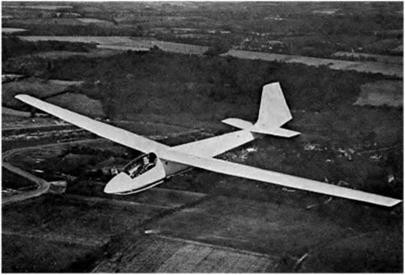Disadvantages of flat gliding angle
It should not be thought that a flat gliding angle is always an advantage; when approaching a small airfield near the edge of which are high obstacles, it is
|
|
Fig 6A Gliding
(By courtesy of Slingsby Sailplanes Ltd)
The Skylark 4 with large aspect ratio and good value of lift/drag; needing spoilers to increase gliding angle when necessary.
advisable to reach the ground as soon as possible after passing over such obstacles. In these circumstances a flat gliding angle is a definite disadvantage, and even if the aeroplane is dived steeply it will pick up speed and will tend to float across the airfield before touching the ground.
The gliding angle can be steepened by reducing the ratio of lift to drag; this can be done by decreasing the angle of attack (resulting in too high a speed), or by increasing the angle of attack (resulting in an air speed which may be too low for safety), or by using an air brake (Fig. 6.5). The last is by far the most satisfactory means, and the air brake may take the form of some kind of flap, such as was described in the chapter on aerofoils; but the modern tendency is to use the various types of flap when lift is required, and separate air brakes or spoilers when drag is required.















